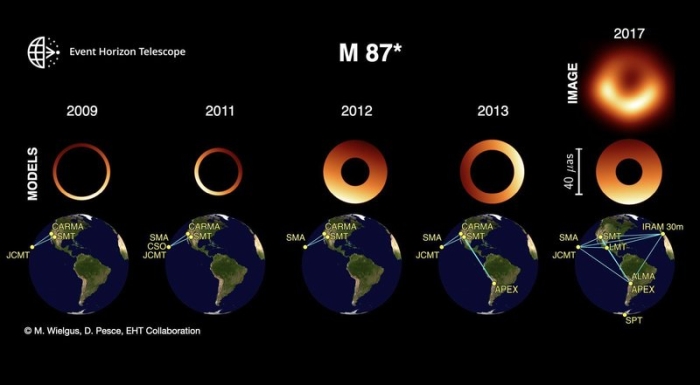Last year, for the first time, the world gazed in collective wonder at an actual direct image of a black hole's shadow.
Now, looking back at earlier, more rudimentary images, scientists have found evidence that the ring around M87* has a wobble that makes it look as though it's glittering.
Last year's history-making image was a feat of hard work that pushed our observation technology to the limits. It was the culmination of years of effort and planning - but the final image was put together from only one week's worth of observations, taken in 2017.
In the earlier years of the Event Horizon Telescope project, though, the team took observations of the target - the black hole at the centre of a galaxy called M87, located 55 million light-years away - using prototype telescope arrays.
Those observations, taken between 2009 and 2012, did not collect enough data for an image.
But, when astronomers were seeking to determine how the ring around the black hole changes over time, they found there was enough data to confirm a simulation of how the ring's brightness fluctuates.
 (M. Wielgus, D. Pesce & the EHT Collaboration)
(M. Wielgus, D. Pesce & the EHT Collaboration)
"Last year we saw an image of the shadow of a black hole, consisting of a bright crescent formed by hot plasma swirling around M87*, and a dark central part, where we expect the event horizon of the black hole to be," explained astronomer Maciek Wielgus of the Harvard Smithsonian Center for Astrophysics.
"Based on last year's results we asked the following questions: is this crescent-like morphology consistent with the archival data? Would the archival data indicate a similar size and orientation of the crescent?"
The team used a statistical modelling approach based on the framework used for the analysis of the 2017 data. That data also formed the starting point for their model, and the data obtained from the prototype arrays were used to constrain it.
And they found, as predicted by general relativity, that the black hole shadow - the circle in the middle of the glowing golden ring - was persistent throughout the time period, maintaining the same diameter over years. This is yet further confirmation of the nature of M87*, the researchers said.
While that result was expected, however, another result was not.
When you look at the image of M87*, you can't fail to notice that part of the ring is much brighter.
That ring is made up of dust and gas that's swirling around and feeding into the black hole in an accretion disc, and the uneven brightness is another effect predicted by general relativity, called the Doppler effect.
As part of the ring rotates towards us, the viewer, it appears brighter; the part that's rotating away appears fainter.
In their reconstruction, the team found that that bright region isn't fixed in place - it moves around, appearing to glitter or wobble.
The team attributes this movement to turbulence in the flow. And that tells us a lot about the regions around a supermassive black hole, and the impact it has on the material around it.
"Because the flow of matter is turbulent, the crescent appears to wobble with time," Wielgus said.
"Actually, we see quite a lot of variation there, and not all theoretical models of accretion allow for so much wobbling. What it means is that we can start ruling out some of the models based on the observed source dynamics."
There could be any number of things causing the turbulence in the flow. The magnitude of the black hole's spin is one. The magnetic field structure in the accretion disc itself is another.
It could be driven by magnetorotational instability, or a misalignment in the black hole's spin and the accretion flow.
It could also have a relationship with the formation of relativistic jets. Those are powerful streams of plasma from the inside of the accretion ring that are accelerated around the outside of a black hole's event horizon and launched into space at relativistic speeds.
We think we know how they form, but we're not entirely sure, so M87* could help us figure it out.
Because the earlier data are relatively weak, it's not really possible to draw any conclusions - yet. But the Event Horizon Telescope's work is far from done. It consists of a network of radio telescopes that span the globe, and every new facility that adds its capabilities to the collaboration only increases its power.
Another telescope was added for observations in 2018 - that data is currently under analysis. More observations with two more telescopes joining the fray will be taking place next year.
"The enhanced imaging capabilities provided by this extended array will provide a more detailed view on the shadow of the black hole M87* and on the innermost jet of the M87 radio galaxy," said astronomer Anton Zensus of the Max Planck Institute for Radio Astronomy in Germany.
We can't wait to see what they find.
The research has been published in The Astrophysical Journal.
#Space | https://sciencespies.com/space/the-giant-black-hole-we-imaged-for-the-first-time-now-appears-to-be-glittering/
No comments:
Post a Comment